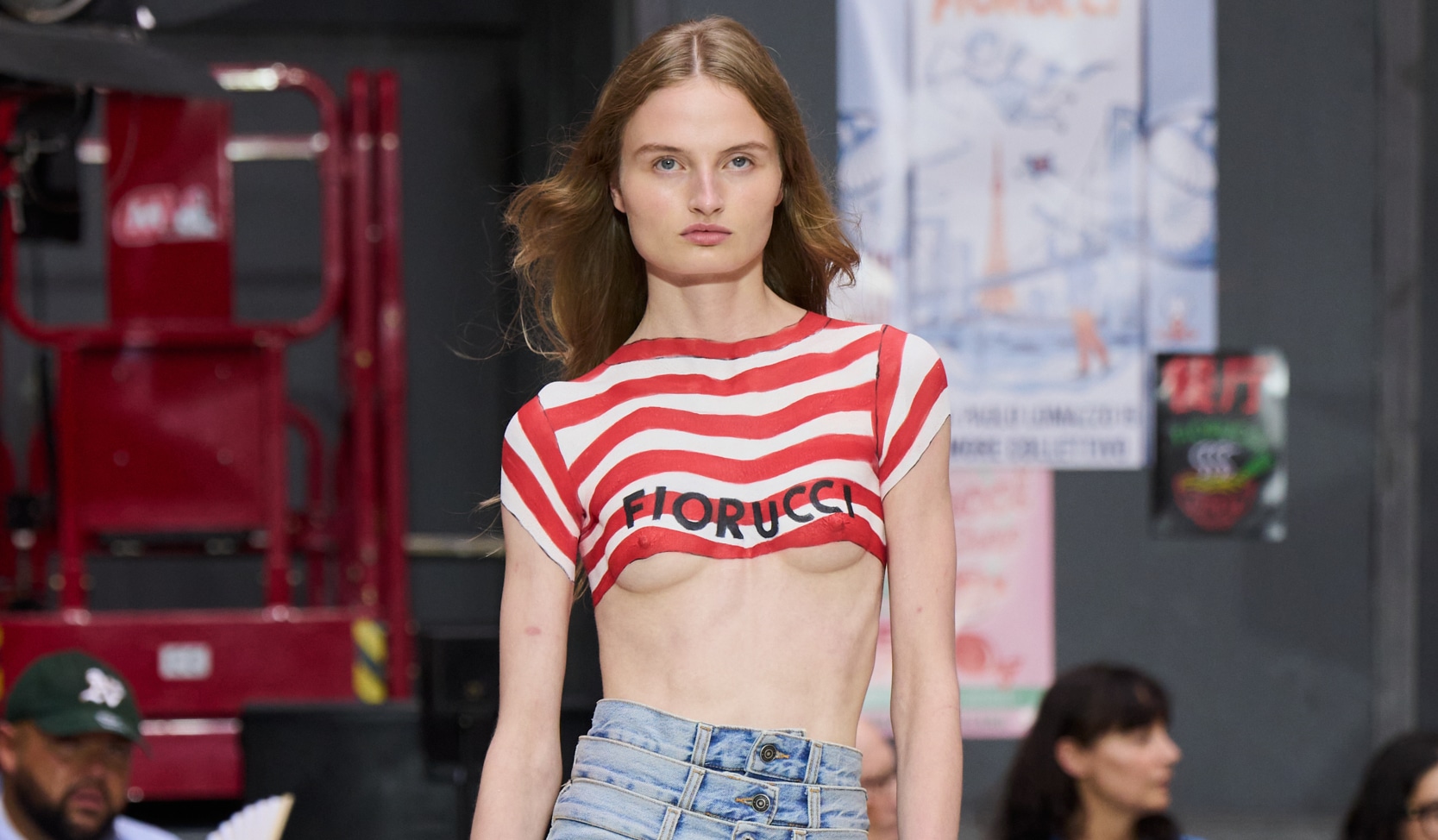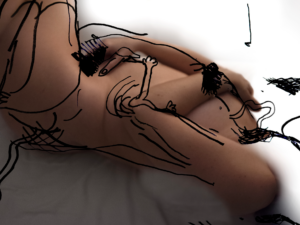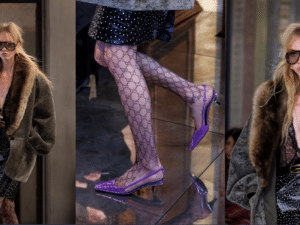A Conversation with Berlin-based artist, curator, and composer of Body x(n), Magdalena Jadwiga Härtelova
An Immense Capacity for Expansion
Body x(n) is a poem for six voices. It is spoken word on sheet music. It is an audio recording, a performance, a traveling installation specific to no place yet specific to all places the body in any capacity can go, as well as to some places it cannot. It was conceived during Härtelova’s residency at the Anchorage Museum of Art, produced and released on cassette, and promptly acquired into the Alaskan museum’s permanent collection.
The piece speaks of a body traveling through varying stages: past, present, and yet-to-come. It is a body in dialogue with itself in different dimensions, primarily taking on characters of a Pregnant Body, a Body in the Process of Abortion, and the Body That Afterward Remains. Supporting characters take the roles of appearing and disappearing matter and molecules.
Body x(n) is a sprawling oeuvre of conceptual work that has continued growing worldwide with various collaborations: musician Slowfoam layed a soundscape below the voices which can be heard on the cassette tape, Härtelova’s partner performs an improvisational ambient score for the live shows, Solene Milcent contributed an analogue photoshoot inspired by the piece, and recently a music video directed by Imogen Mansfield was released as an accompaniment.
I spoke with Härtelova on what led her to create such a work: on the personal process, on the questions that it poses, on the the relations she made, and on some answers she found along the way.
Will you tell me a bit about how this idea was initially formed?
In 2018, I found out I was pregnant. My understanding of myself and the world around me turned upside down, and I was immediately presented with many questions I had never had to answer, in a way I was not prepared to answer so abruptly. I am an artist, and it is natural to consider that when I make art, it is a way of making sense of the things around me, in a way that encompasses the complexities and contradictions of the actual experience itself, rather than forming and expressing the experience in a scientific fashion, or giving a methodical and rational process to any given topic.
There is much more nuance to an experience when placed through an artistic lens rather than a scientific one.
A part of this piece questions where things appear and where they do not. Philosophically speaking, if something does not physically exist or appear in front of me- yet I know it is real simply because of other factors around it that can exist only because of this other invisible force- in what form and at what point is anything considered real? Is it dependent on tangibility? Actuality? When am I old? When am I a woman? When am I a mother? These are questions about transgressing transcendence. It took my mind a longer amount of time to know I was pregnant than it took my body to know, yet it took my body longer to know I was no longer pregnant than it took my mind. Things physically appear only after the initial forming of existence, which is to say, a lot has been around for much longer than we ever thought it was, and so I think the same can be said about something disappearing: just because it has left a physical plane, does not mean it is not actually still there.
The format of your composition is existential and speaks on the concept of transcendence. The movements of the piece are entitled: Disappearing, Change, Appearing.
In the footnotes, I mention that the piece may be performed backwards, in a way, expressing that the end may look just as the beginning did, that even perhaps the end is actually be the beginning in and of itself.
You are a visual and performative artist, yet this piece has taken on the form of composition. Tell me about how this came to be over any other medium.
I did not start writing this composition until half a year after my abortion surgery, but already the writing was there. Writing the piece was more like a collaging process. I had been writing down notes and various thoughts going through my head; I was quoting friends who said things I wanted to remember. Reading these notes was like tracing change. When I began creating the piece as it has become, I was at a point where I did not want to talk about my feelings anymore. I wanted to create a space with ample room for others to add to the conversation, to relate in ways also outside of pregnancy and abortion. I did not want to make an object, or a statement. I wanted to create a tool that allowed the questioning of forms of existence. This to me was more valuable than making a physical piece of artwork that ultimately would have been but a form of therapy for myself, rather than an exercise in bringing others together in discussion.
What did the process of creating Body look like?
It began last year in Berlin, in the springtime. My now-husband John and I were living in an apartment close to Tempelhof and we had a separate workroom together. We would take turns: him making music and me making art, and there was also a lot of creative overlap together during this period. At the time, I was curating an exhibition at the Academy of Fine Arts in Prague. Two of the artists were mothers. In their artwork, they explored niches of time. They took ownership of their motherhood through their art, while critiquing patriarchal critiques of feminist art. They were intelligent and inspiring to me. I had met these women one week after my abortion. I knew that while my pregnancy did not look like theirs, my pregnancy may have looked like someone else’s, and I felt compelled to share my story of motherhood. That summer, I went on to serve as an artist-in-residence in Alaska at the Anchorage Museum. It is here, and with their support, that I was able to focus upon and finish the composition.
There is a social aspect to Body, and it mainly consists of women coming together and participating in candid dialogues about their experiences. After your first performance in Berlin, many in the audience felt a space was created to talk candidly about their own stories amongst each other, to contrast, to compare, to have the space to be heard and to be honest. This frankness seems to be missing from most conversations about abortion in normalized social conventions.
When I first found out I was pregnant and thinking about what is next for me, I quickly realized the references and opinions that are readily available are fairly binary. The options are either emancipation by abortion, which holds in it a lot of diminished concerns and callousness toward the emotions of carrying a child within you. I also did not resonate with the capitalistic marketing techniques of happy smiling women who found freedom in abortion. On the flip side, I was told by numerous people that if I did not lean into the pregnancy and go through with it, that I may come to regret it. There is a social negligence in the lack of responsible conversations surrounding the emotions of women during a highly vulnerable time in their lives. This experience is not as black and white as the political conversations make it out to be. I think many women recognize this, and I have seen them speak in complexities around the difficulties they and their friends and family are facing. It’s obvious when a woman chooses pregnancy. Everyone can see it, they hear about it. But when a woman is grappling with an abortion, it is not always so obvious. It’s certainly not socially acceptable to talk about it in a joyous fashion, even though it should be embraced.
Another thing that is not too common is hearing the mans’ perspective of going through an abortion with their partner. And while we are now trying to be more conscious of men expressing and owning their emotions more freely than they have in the past, men still deal with this process fairly independently. They are not given much of a support system, let alone a platform, to talk about their experience. I rarely hear of the man’s side of processing emotions before and after abortion, however, your husband John has been alongside you for the duration of this, and he also contributes to the live performances.
This was a big learning curve for our relationship, and at times it was hard to relate to each other through the process, but that is to be expected. Our fears were different. What this meant for our lives was different. We had a conversation about what we wanted from our lives, both separately and also as a unit. Did he want to be a father? Did I want to be a mother? We had to ask each other these questions that we first had to ask and answer for ourselves. After the abortion, I gave him an interview, actually, about how the process was for him. Some of his words made it into the score. His way of coping was different from mine, but just as valid. He said that the possibility is only as big as we let it grow in our minds. He consciously decided not to have it grow too far, to not let it fester into something it was not. He put more effort into caring for me, rather than putting too much of his energy into dwelling on not having the baby. I wanted to include his perspective in the piece, because while it was ultimately a decision based upon what I wanted, his feelings were taken into account and they were just as important to me. For the performances of Body in Prague and Berlin, John improvises a synth soundscape, morphing it into one of the voices. The piece itself is incredibly fluid and moves in unpredictable, undetermined ways. The synth was to be yet another reactionary voice that shifts organically as the differing voices do. It changes with every performer, in each performance.
Just like the concept for Body x(n), there appears to be no pre-determined end to this creative endeavor, nor can its capacity be predicted by anything other than its forward motion of navigating around obstacles, finding answers that beg to ask more questions along the way. While there may be a score, there is no guidebook. We look forward to seeing what comes next out of the Body. The end may be just the beginning.
Pictures: Body x(n)
Text: Janna Shaw



